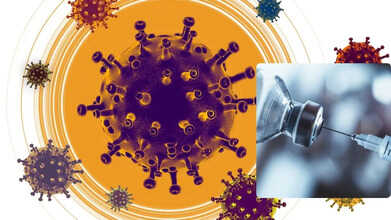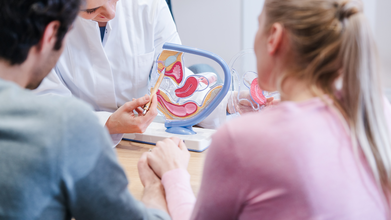- Health Conditions A-Z
- Health & Wellness
- Nutrition
- Fitness
- Health News
- Ayurveda
- Videos
- Medicine A-Z
- Parenting
- Web Stories
Sunita Williams Returning To Earth Finally, What Health Concerns Loom Over Her?

Source: NASA
The wait is over and the stranded duo of US astronauts are finally going to return to Earth from the International Space Station (ISS) on Tuesday (March 18) evening, said NASA.
The duo, Butch Wilmore and Sunita Williams will be transported home with another American astronaut and a Russian cosmonaut aboard a SpaceX Crew Dragon craft, which had arrived on ISS early on Sunday.
The duo was initially out for an 8-day long mission to ISS, which got extended for nine months due to a Starliner spacecraft problem. Not only this extension is mentally draining, doctors had long been concerned about the other health impacts a long space duration can do.
The spacecraft was launched on June 5, and following a glitch in its thrusters, essential to propel the spacecraft, the duo has been stuck indefinitely. The primary issue is with its propulsion system, particularly gas leaks and malfunctioning thrusters, which have raised significant safety concerns and led NASA to even reconsider its use for astronaut transport. The Space Agency, as reported in The Guardian also said that there was "too much uncertainty" for the astronauts to return on the craft that brought them to the station.
How Do Astronauts Survive On Long Missions?
"The space station is well-stocked with everything the crew needs, including food, water, clothing, and oxygen. Additionally, NASA and its space station partners frequently launch resupply missions to the orbiting complex carrying additional supplies and cargo," said the space agency in a statement.
NASA had earlier said that it has plans to launch a SpaceX resupply mission by the end of 2024. Crew living on board the ISS also have access to Vegetable Production System (Veggie) which is investigation the growth of plants in space. With this system fresh plants can be grown that can provide astronauts with nutritious fresh food. Both, Williams and Wilmore are also testing the different space crop techniques.
So Are There No Health Risks?
Space agencies like NASA and the German Space Agency (DLR) studied the effects of space on human body. In 2024, the journal Nature published over 40 studies focused on aerospace medicine and space biology. One such study, called TWINS compared astronaut Scott Kelly, who spent a year on the ISS with his identical twin, Mark, who stayed on Earth.
The study highlighted a significant risk of prolonged space missions: radiation exposure.
Radiation in space can damage DNA, increasing cancer risks and oxidative stress in the body. Bailey explained that space radiation exposure is a major concern for astronauts. Space agencies must find ways to protect astronauts during space travel and long-term stays on the Moon or Mars. They have set limits on the amount of radiation astronauts can be exposed to over their careers.
Another challenge is microgravity that causes bone density loss of 1-1.5% per month. When astronauts come down to Earth. They may struggle with physical activities like dancing due to weak bones and it can also affect vision. The fluids that shift to the head put pressure on the eyes. This can also lead to Spaceflight Associated Neuro-ocular Syndrome, which can permanently impact vision.
Other risks involve fluid redistribution that can lead to facial puffiness and decreased fluid volume in legs, disruption of cardiovascular functions, complicating blood pressure and even risks to the urinary systems. The risk of kidney stone too is high.
Nutrition deficiencies was another concern which was raised when photos of Williams revealed a significant weight loss. Her sunken cheekbones raised worries about her eating habits. There were also speculations of her being on a calorie-deficit diet. This meant that she ate less than her body required to sustain the high energy she needs for space travels.
In terms of physical activities, astronauts in microgravity must exercise for 2.5 hours daily. This helps them maintain muscle bone health. However, challenging environment could lead to weight loss.
What must be done after the duo returns to Earth is a regular health monitoring that could track the long-term effects of their time in space.
Melatonin or Magnesium: Which One Actually Helps You Sleep Faster?

Credits: CANVA
Getting good-quality sleep does more than just help you wake up refreshed—it could also extend your lifespan. A 2023 study found that people who consistently fell asleep easily, stayed asleep through the night, and woke up feeling rested had a significantly lower risk of early death, and were 30% less likely to die from any cause, 21% less likely to have heart disease, 19% lower risk of cancer, and 40% lower risk from other causes.
Given these benefits, it’s no wonder many turn to supplements to improve their sleep. Two of the most popular options are melatonin and magnesium. But which one truly helps you drift into deep, peaceful sleep?
Role of Melatonin In Sleep
Melatonin is a hormone naturally produced by the body that helps signal it’s time to sleep,” says Kenneth Lee, M.D., medical director of the Sleep Disorders Center at UChicago Medicine. According to the Mayo Clinic, melatonin levels rise in the evening when it gets dark and drop in the morning with daylight. “It regulates your circadian rhythm, telling your body when to rest,” adds dietitian Stephanie Crabtree, M.S., R.D.
Melatonin production stays steady through young adulthood but begins to decline after age 40, according to the Cleveland Clinic. That’s one reason melatonin supplements are often studied for older adults. Dr. Lee notes that it can be especially helpful for issues like jet lag, shift work, or misaligned sleep schedules. “If you’re someone who can’t fall asleep until 1 a.m. but need to wake up early, melatonin taken at the right time can help shift your body clock,” he explains.
A 2022 review in Neuroscience & Biobehavioral Reviews found that melatonin helped people with sleep and neurodevelopmental disorders fall asleep faster and stay asleep longer. However, research is mixed for those using it as a general sleep aid. A Sleep Medicine Reviews analysis of 24 studies concluded that melatonin may help some people but is not consistently effective for all.
Side Effects of Melatonin
According to the Mayo Clinic, oral melatonin can sometimes cause headaches, dizziness, or nausea. Less common effects may include mild tremors, anxiety, or confusion. It can also interact with medications such as blood thinners, diabetes drugs, and contraceptives, so it’s important to consult your doctor before use.
How Magnesium Supports Better Sleep
Magnesium is a vital mineral involved in hundreds of body processes, including those linked to rest. “It helps calm the nervous system, relax muscles, and regulate neurotransmitters, which together promote sleep,” says Crabtree. It also supports the body’s natural production of melatonin.
Unlike melatonin, magnesium doesn’t directly trigger sleep but may improve relaxation and reduce nighttime restlessness. “It helps regulate GABA, a neurotransmitter that quiets the brain,” says Dr. Lee. A 2024 study in Sleep Medicine: X found that magnesium L-threonate supplementation improved sleep quality, though the results were based on self-reported data. “In my experience, some patients find magnesium helpful, while others notice little change,” Dr. Lee adds.
Side Effects of Magnesium
According to Dr. Lee, magnesium may cause nausea, diarrhea, or stomach cramps, especially at high doses. The NIH also notes that it can interfere with certain medications, including antibiotics, diuretics, and drugs for osteoporosis or acid reflux.
Melatonin vs. magnesium: Which Is Better?
Research remains inconclusive on which supplement works best. “Melatonin may help if your main issue is falling asleep, or if you’re adjusting to jet lag or shift changes,” says Crabtree. “But magnesium can be more effective for restless nights or tension that keeps you from relaxing. It also supports deep, restorative sleep and can be used safely for longer periods.”
Natural Ways To Sleep Better
Before turning to supplements, experts suggest improving your sleep habits. Dr. Lee recommends:- Practicing good sleep hygiene: Use your bed only for sleep and intimacy, avoid screens or heavy meals before bed, and create a calming pre-sleep routine.
- Trying cognitive behavioral therapy for insomnia (CBT-I): This structured approach helps retrain your mind and body for better sleep.
- Getting screened for sleep disorders: Persistent sleep problems may signal conditions like sleep apnea or restless legs syndrome, which require medical care.
Dietary supplements are meant to complement your diet, not replace medical treatment. They are not designed to diagnose, treat, or cure illnesses. Always consult a healthcare professional before starting any supplement, especially if you are pregnant, breastfeeding, or considering giving it to a child.
Is The ‘Frankenstein’ COVID Variant The Most Vaccine-Resistant Strain Yet?

Credits: CANVA
The Stratus strain, also known as the ‘Frankenstein’ variant, belongs to the SARS-CoV-2 XFG and XFG.3 lineages and has been spreading swiftly across the United Kingdom, with evidence suggesting it is also circulating globally. According to recent data from the UK Health Security Agency (UKHSA), these variants now account for nearly 30 percent of all COVID-19 cases in England, with XFG.3 emerging as the most dominant strain.
In recent weeks, medical experts have voiced concerns that the Stratus variant might have the ability to partially evade immunity built through vaccination, potentially increasing infection risks across all age groups.
What Sets the Stratus or ‘Frankenstein’ Variant Apart?
One of the unusual symptoms linked to this strain is a hoarse or raspy voice, which doctors say was rarely reported with previous variants. “Unlike earlier strains, Stratus carries specific mutations in its spike protein that may allow it to slip past antibodies formed through prior infection or vaccination,” explained Dr. Kaywaan Khan, a Harley Street general practitioner and founder of the Hannah London Clinic.
Is the Stratus Variant More Transmissible?
The XFG or Stratus strain is a member of the Omicron family and is a hybrid of two subvariants, LF.7 and LP.8.1.2. This combination of genetic material helps the virus attach more tightly to human cells, making it potentially more contagious. Like other variants, it also contains several mutations that may enhance its ability to evade antibodies produced either through infection or vaccination.
Could The ‘Frankenstein’ Variant Be The Most Vaccine-Resistant?
Early reports from health authorities suggest that existing COVID-19 vaccines still provide a degree of protection against the Stratus variant. Vaccines designed for earlier strains continue to reduce the risk of severe illness and hospitalization across multiple variants, and experts remain cautiously hopeful that they will do the same against Stratus. However, studies are ongoing to determine how much protection current vaccines actually provide against this specific strain.
As the situation develops, public health recommendations may change. Officials are urging people to follow reliable updates and continue to follow safety advice. Vaccination appointments remain widely available in the UK, and eligible individuals are encouraged to receive their doses or boosters as recommended.
What Are the Symptoms of Stratus?
The most common symptom so far appears to be a sore throat, though overall, the symptoms are similar to those caused by other COVID-19 variants. People infected with Stratus may experience:
- Fever
- Fatigue
- Cough
- Sneezing
- Runny or congested nose
- Nausea, vomiting, or diarrhea
So far, XFG has not been linked to more severe illness compared to previous variants, and hospitalization rates have not shown a sharp increase, which is reassuring.
Why The Stratus Variant Still Deserves Attention
Although it does not appear to cause more severe disease, the Stratus variant is a reminder that COVID-19 continues to evolve. Vaccines remain the strongest line of defense, and researchers are continuing to study how well they perform against this strain. Staying informed through credible sources and following updated health guidance can help limit the spread and keep communities safer.
3 Fertility Truths Every Woman Should Know, According To A Gynecologists

(Credit-Canva)
Infertility impacts millions across the globe, touching both men and women alike. According to the World Health Organization, around 17.5% of the global population, roughly one in six people, experience fertility challenges. This condition can significantly reduce or even prevent natural conception.
Yet, despite its prevalence, infertility remains clouded by myths and misconceptions, many of which unfairly place the blame solely on women. Seeking to debunk these long-held beliefs, Dr. Holly Miller, an American Board-certified obstetrician and gynecologist, took to Instagram to share three important truths every woman should know about fertility.
3 Truths About Fertility Women Should Know
With the help of modern medicine and medical interventions like IVF, fertility treatment can help people boost their chances of reproducing.
Infertility Isn't Just a Woman's Issue
It’s important to understand that infertility affects both partners — it’s not solely a woman’s issue. Blaming only the woman is both unfair and inaccurate. In fact, experts find that the causes of infertility are almost evenly split between men and women.
Roughly one-third of infertility cases are linked to the woman, another third to the man, and the remaining third result from issues affecting both partners — or from causes that doctors are unable to clearly identify.
To identify the cause of infertility, both partners should undergo testing simultaneously. For men, a semen analysis — a quick and straightforward test — is often the easiest and most informative first step.
The "Wait One Year" Rule Changes with Age
Most couples automatically try to conceive for a full 12 months before they think about seeing a fertility doctor. However, the doctor emphasizes that the woman's age is the single most important factor that affects the chances of successful treatment.
If you are under 35 years old: You can safely try for a full 12 months of regular, unprotected sex before seeking a specialist.
If you are 35 or older: You should contact a specialist after only 6 months of trying without success.
If you are 40 or older: You need to see a specialist right away—as quickly as you possibly can.
The doctor explains that after age 35, the woman's egg supply starts to decline more quickly. Time is essential, so couples should strongly ask their doctors for an early referral.
"Unexplained Infertility" Often Means "Undiagnosed Problem"
When a couple is diagnosed with "unexplained infertility," which happens in about 10% to 20% of cases, it means the basic first tests did not find a clear reason. This can be upsetting, but it does not mean you can never have children. In the doctor's experience, the term "unexplained" often means there are hidden problems, such as:
- Small issues with the male partner's sperm that were missed by the basic tests.
- A hidden condition called Endometriosis, which can only be confirmed by a surgical procedure.
- Not having sexual intercourse at the best time or not often enough.
© 2024 Bennett, Coleman & Company Limited

